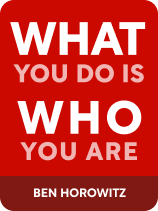

This article is an excerpt from the Shortform book guide to "What You Do Is Who You Are" by Ben Horowitz. Shortform has the world's best summaries and analyses of books you should be reading.
Like this article? Sign up for a free trial here .
As you strive to shape the culture of your organization, what should you expect? How flexible should you be? Does every employee need to be on board?
In his book What You Do Is Who You Are, CEO and venture capitalist Ben Horowitz discusses three cultural challenges that leaders face as they seek to shape their organization’s culture. He explains that they must deal with the fact that culture is both aspirational and actionable, culture is always evolving, and culture is universal.
Continue reading to learn more about these challenges.
Cultures Have Built-In Challenges
We’ll explore some of the factors that Horowitz believes make it challenging for leaders to leverage culture to support their organization’s vision and make it an attractive place to work. Horowitz describes three cultural challenges that you will face as you design and implement your culture.
Challenge #1: Culture Is Both Aspirational and Actionable
The first challenging feature of culture is that you must balance acknowledgment that it’s an unattainable ideal with taking action to get as close as possible. Culture reflects what the organization hopes to become. But Horowitz makes clear that you can’t expect complete compliance with the culture. To get as close as possible to that ideal culture you’ve designed, you must consistently take actions that are in line with the culture. At the same time, the needs of the business will sometimes take precedence over culture, and you might find yourself temporarily breaking a cultural rule because it’s not helpful to the organization’s short-term objectives.
(Shortform note: In Start With Why Simon Sinek clarifies that you can prevent the split between aspirational and actionable by keeping the focus on the “why” or purpose of your organization. Some strategies he offers to keep your focus are:
- Making sure that the “why” trickles from the top down to every single employee
- Measuring the metrics that truly align with your “why”
- Ensuring your company is prepared to transition leadership to people who support the “why” as strongly as current leadership so there’s continuity)
Challenge #2: Culture Is Always Evolving
The second challenging feature of culture is that it needs to continuously evolve to allow the organization to move forward. Hanging on to culture as dogma can keep an organization stuck in modes of behavior that served the original strategy but no longer move it in a direction of growth. In addition, Horowitz warns that cultural strengths can become weaknesses. If the organization leans too heavily on a particular characteristic, it can go to a detrimental extreme. For instance, overemphasizing horizontal organization caused a crisis at Zappos in which people chose to leave the company rather than try to get their jobs done in a confusing flat structure.
(Shortform note: This challenge also points to a balancing act that culture leaders must enact: maintaining the organization’s core cultural identity without letting it calcify into dogma. In Built to Last, Collins and Porras provide actionable steps for leaders to sustain that balance, including maintaining a core ideology by fostering a cult-like workplace centered on its values and promoting from within, and stimulating progress by committing to challenging goals, experimenting, and never settling for “good enough.”)
Challenge #3: Culture Is Universal
The final challenging feature of culture is that it must permeate every aspect and area of your organization, so there are no inconsistencies that lead to confusion or frustration. Horowitz notes that everyone has to be on board with the culture, from rank-and-file employees to investors, so that they all pull in the same direction.
(Shortform note: Culture experts highlight that not fostering a cohesive identity throughout an organization can lead to compartmentalization and the creation of silos, which endangers the integration necessary in moments of major change, such as a digital transformation. They point out two challenges that must be tackled in order to bring cohesion to an organization:
- Not being able to let go of projects, even successful ones, to embark on unknown but potentially more beneficial ones outside of the organization’s comfort zone
- Making frequent exceptions that seem small on their own but together amount to huge diversions from the organization’s core)
The exception to the universality of culture is the organic development of subcultures that reflect the characteristics of specific teams, such as marketing or accounting. Horowitz explains that an organization’s core characteristics are relevant to the entire culture, but some of its characteristics apply only to specific subcultures. For example, Facebook’s early motto, which encouraged employees to “move fast and break things,” was important guidance for engineers and designers, but probably less useful to the legal or accounting departments.
(Shortform note: Beyond pragmatic reasons, subcultures can help companies be more flexible and inclusive without losing their dominant cultural traits. By allowing subcultures to emerge, companies can keep their internal coherence and still be able to deploy specific teams to respond to fast-paced developments in their environment, such as disruptive technologies or unforeseen competition. On the other hand, subcultures that form around demographics rather than teams can help employees from diverse backgrounds find a group in which to feel at home without losing their ties to the organization’s broader culture.)
Example: Andreessen Horowitz’s Focus on Entrepreneurs
Horowitz offers an example from his own experience that illustrates the three challenging characteristics of culture. When he co-founded the venture capital firm Andreessen Horowitz, their culture served their strategy: being an entrepreneur-focused venture capital firm. They were in business to support visionary entrepreneurs, and their mission was to give them the necessary support to bring their visions to life.
Their culture was actionable: They supported entrepreneurs by having only experienced former founders or CEOs sit on their boards. They also provided founders with an extensive network of press, talent, and resources through the firm’s junior employees.
Their culture was aspirational: Although the ethos of the firm was to make the entrepreneur the focus, the experienced founders and CEOs that sat on the boards of the firms they funded enjoyed being in charge and didn’t always go along with Andreessen Horowitz’s belief of showing the utmost respect to the entrepreneur.
Their culture was universal: Their culture affected every aspect of the firm’s operations and not always for the best. Because of the rule that only experienced founders or CEOs sat on the boards of the companies they funded, Andreessen Horowitz never promoted their junior employees to general partnership. Thus, junior employees left the company quickly and often—taking with them the culture, skills, and network insight entrepreneurs needed.
Their culture was continuously evolving: Horowitz realized that to continue being an entrepreneur-focused firm, Andreessen Horowitz had to break their rule and start promoting their best junior employees to general partnership. This allowed them to keep their best cultural advocates, support their entrepreneurs, and continue growing beyond their initial strategy.
(Shortform note: This example also showcases other challenges that experts on organizational culture have highlighted:
- Employees bring their own cultures to the organization, like Andreessen Horowitz’s CEO partners who brought their own cultures to the firm and didn’t always align with the firm’s values.
- If culture is only expressed through values and symbols, employees cannot acquire it since they learn experientially. Andreessen Horowitz understood this, and they set rules and policies based on their culture.)

———End of Preview———
Like what you just read? Read the rest of the world's best book summary and analysis of Ben Horowitz's "What You Do Is Who You Are" at Shortform .
Here's what you'll find in our full What You Do Is Who You Are summary :
- The three reasons leaders should care about culture
- How a sense of purpose boosts employees' performance
- What the Samurai and Genghis Khan can teach you about leadership






